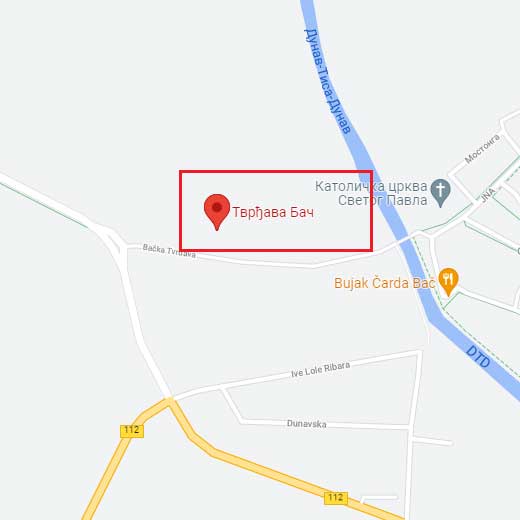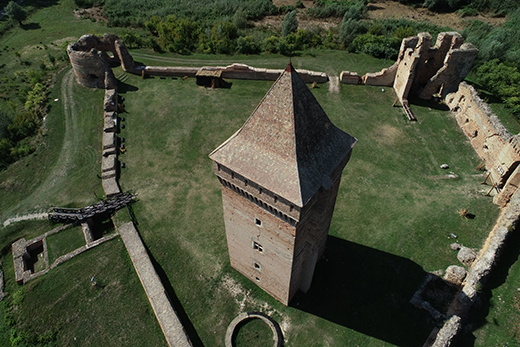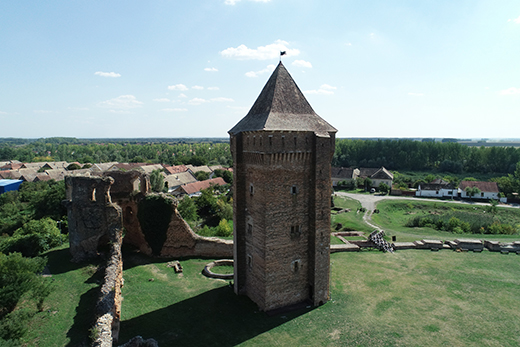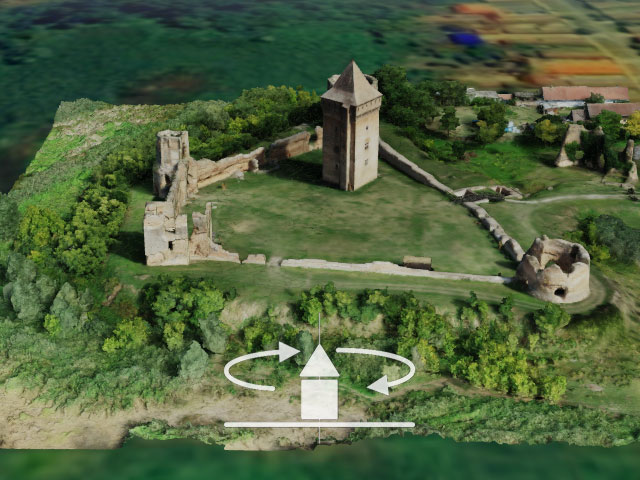Bač fortress
Protected cultural monument of extraordinary significance, listed as PKIC 52 with the Republic Institute for the protection of monuments of cultural heritage.
Bač fortressBač municipality, South Bačka District
Where is it
Bač fortress is located in the western part of the town Bač, after which the entire valley between the rivers Danube and Tisa is named Bačka. It was built on a former island surrounded by the river Mostonga and one of its tributaries. It used to be reflected in the water, but after the meanders of the Mostonga river had been straightened out in order to build the hydrosystem Danube-Tisa-Danube, the whole environment changed. Today, the fortress can be reached via the concrete pedestrian bridge from the direction of Bač. The access with a vehicle is also possible by using the Bač-Vajska road. Although not directly on the Danube, it is considered one of the Danube fortresses.

Research
The first research of Bač fortress in 1870 was led by Hungarian art historian and archaeologist E. Henslman. In the late 50s of the 20th century, archaeological research was conducted by the Museum of Vojvodina. The systemic research started in 1980 and lasted for about ten years.
After a lengthy pause, more in-depth research was continued in 2003. After several years, in 2006, the research grew to become a project “Centuries of Bač” that had as its aim further research as well as conservation and revitalization of the fortress and its adjoining settlement. The project was realized by the Provincial institute for the protection of cultural monuments Petrovaradin, with the support of the Fund for the protection of cultural historical heritage Centuries of Bač, Faculty of technology Novi Sad and the Museum of Vojvodina. Financial support was provided by regional, national and international institutions, as well as the European Union.
The success of the project can be seen in the restauration of the fortress and the presentation of the research results inside the edifice. The place became a centre for gaining professional knowledge on preservation and management of the cultural heritage. In 2010, Bač was put on the tentative UNESCO list, and the project received the Europa Nostra award in 2018 as an exceptional example of the preservation of cultural heritage based on the interdisciplinary cooperation.
History
The area where the Bač fortress was built used to be inhabited as early as the neolith; the life continued during bronze and iron age, as corroborated by research. It appears that in the 3rd and 4th century the area was inhabited by the Celts.
The first written sources are from the times of Byzantine emperor Justinian I, who mentions it in a letter from 535 AD. In the 9th century it was an Avar fortification. During the Arpadovic reign it was a royal city and the seat of the diocese. The Mongols destroyed the city in 1241, and the renewed fortress was later the fortification of powerful Hungarian lords.
The castle in Bač was built between 1338-1342, during the Hungarian king Charles Robert I. The fortress gained its final shape in the 15th century when its southern border was fortified as the defence from the Turks. The river Mostonga was then expanded in order to enable the ships from the Danube to access the city. The fort was surrounded by water from all sides, and entered via a drawbridge.
The Turks conquered the fortress in 1529, and, according to Evliya Çelebi, used it until the liberation in 1686.
The fortress was blown up during the Hungarian Rákóczi uprising in the early 18th century.
The adjoining settlement was formed in the 18th century.


Description
The medieval fortification Bač is the most important and best-preserved fortress in the entire Vojvodina. On the elevation formed by the meanders of the river Mostonga, there was a fenced settlement that could be entered over the bridge and through the gate protected by the entrance tower.
On the very island, in the north-western part, a fortified castle was built. The fortification was erected on a small plateau of surface of 8.700 m2, while the fortress itself has the surface of 5.600 m2. The ramparts follow the configuration of the terrain; the width of the rampart was 2,5 m and the height 12 m, with a pathway on top. The corners of the rampart had extruding towers, three with circular bases and the other two with quadrangular bases. In the eastern part there was a dungeon tower, and the residential palace next to it. Aligned with the western wall, there were several auxiliary facilities as well as grain storage pits.
All objects were made of brick, while stone was used for decorative elements. Various destructions in the past have ruined the wholeness of the object, however, the elements that have been preserved represent important architectural achievement of High Gothic period with some elements of the early Renaissance. The keep is the most dominant and the only completely renovated edifice of the castle. It is the oldest form of residential tower, resembling wooden towers. Positioned in the middle of defensive space, the keep served as a temporary residence in the event of a siege. It contained the food storage, a fireplace, a well, and sanitary areas. From its height one could observe the surroundings.
Bač fortress is a unique monument in the Vojvodina area, a well-preserved residential complex of great historical significance.
The adjoining settlement is a separate unit of the object. It was founded in late 19th and early 20th century, according to the urbanistic matrix from the 18th century. It consists of two rows of arranged houses of Pannonian type with baroque gables, on small rectangular plots of similar dimensions. These developed Pannonian houses have porches along the outside facades with wooden or built pillars. They represent a level of development of village house towards the city one; each house has special decorative elements ranging from classicistic, calm ones to ornate, baroque ones. The settlement is adjacent to the fortress and together with it creates an inseparable ambient whole of extraordinary significance that preserves the characteristics of a settlement from the Austro-Hungarian times.
Julka Kuzmanović Cvetkovićarcheologist
